Chapter 5: Selecting Business-Level Strategy
Focused Cost Leadership and Focused Differentiation
Learning Objectives
- Describe the nature of focused cost leadership and focused differentiation.
- Know the advantages and disadvantages of focus strategies.
Companies that use a cost leadership strategy and those that use a differentiation strategy share one important characteristic: both groups try to be attractive to customers in general. These efforts to appeal to a broad range of consumers can be contrasted with strategies that involve targeting a relatively narrow niche of potential customers. These latter strategies are known as focus strategies (Porter, 1980).
The Nature of the Focus Cost Leadership Strategy
Focused cost leadership is the first of two focus strategies. A focused cost leadership strategy requires competing based on price to target a narrow market (Figure 5.12 “Focused Cost Leadership”). A firm that follows this strategy does not necessarily charge the lowest prices in the industry. Instead, it charges low prices relative to other firms that compete within the target market. For example, you might be able to buy milk cheaper by driving to a big-box grocery store in your local community or town, but the local corner store is the cheapest within walking distance. Redbox, a major DVD rental company, uses vending machines placed outside grocery stores and other retail outlets to rent DVDs of movies for $1. There are ways to view movies even cheaper, such as through the flat-fee streaming video subscriptions offered by Netflix. But among firms that rent actual DVDs, Redbox offers unparalleled levels of low price and high convenience.
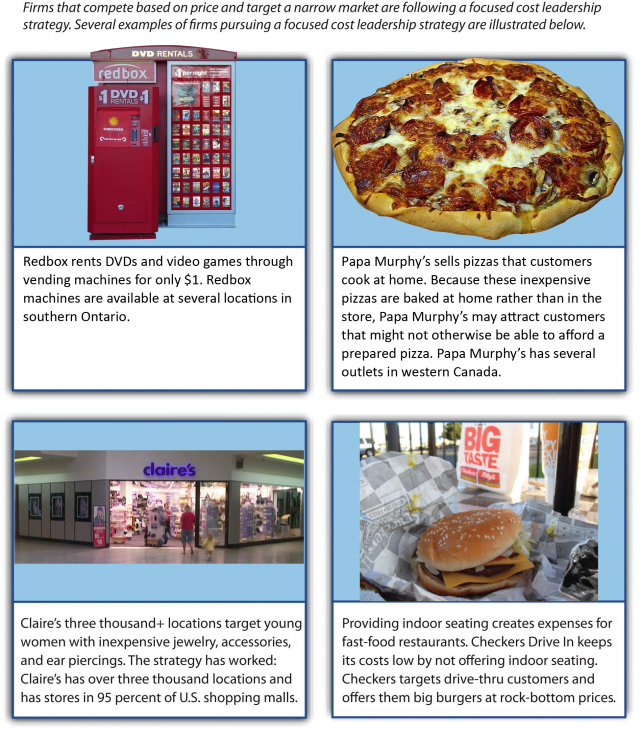
Another important point is that the nature of the narrow target market varies across firms that use a focused cost leadership strategy. In some cases, the target market is defined by demographics. Claire’s, for example, seeks to appeal to young women by selling inexpensive jewelry, accessories, and ear piercings. Claire’s use of a focused cost leadership strategy has been very successful; the firm has about 50 locations in Canada, located in shopping malls.
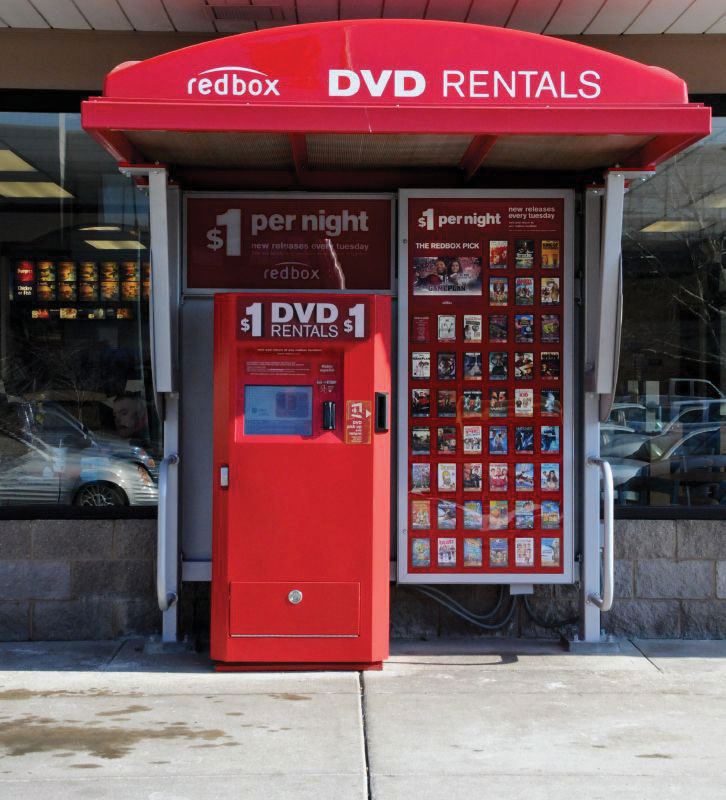
In other cases, the target market is defined by the sales channel used to reach customers. Most pizza shops offer sit-down service, delivery, or both. In contrast, Papa Murphy’s sells pizzas that customers cook at home. Because these inexpensive pizzas are baked at home rather than in the store, Papa Murphy’s may attract customers that might not otherwise be able to afford a prepared pizza. In contrast to most fast-food restaurants, Checkers Drive In in the United States is a drive-through-only operation. To serve customers quickly, each store has two drive-through lanes: one on either side of the building. Checkers saves money in a variety of ways by not offering indoor seating to its customers—its buildings are cheaper to construct, its utility costs are lower, and it needs fewer employees. These savings allow the firm to offer large burgers at very low prices and still remain profitable. Checkers is not in Canada yet.
The Nature of the Focused Differentiation Strategy
Focused differentiation is the second of two focus strategies. A focused differentiation strategy requires offering unique features that fulfill the demands of a narrow market (Figure 5.14 “Focused Differentiation”). As with a focused low-cost strategy, narrow markets are defined in different ways in different settings. Some firms using a focused differentiation strategy concentrate their efforts on a particular sales channel, such as selling over the Internet only. Others target particular demographic groups. One example is Breezes Resorts, a company that caters to couples without children. The firm operates seven tropical resorts where vacationers are guaranteed that they will not be annoyed by loud and disruptive children. While a differentiation strategy involves offering unique features that appeal to a variety of customers, the need to satisfy the desires of a narrow market means that the pursuit of uniqueness is often taken to the proverbial “next level” by firms using a focused differentiation strategy. Thus the unique features provided by firms following a focused differentiation strategy are often specialized.
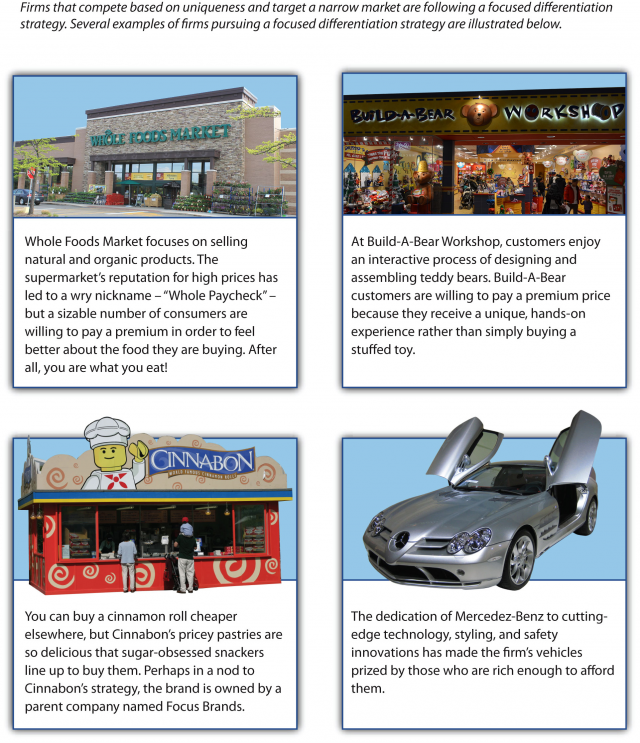
When it comes to uniqueness, few offerings can top Kopi Luwak coffee beans. High-quality coffee beans often sell for $10 to $15 a pound. In contrast, Kopi Luwak coffee beans sell for hundreds of dollars per pound (Cat’s Ass Coffee, 2010). This price is driven by the rarity of the beans and their rather bizarre nature. As noted in a 2010 article in the New York Times, these beans are found in the droppings of the civet, a nocturnal, furry, long-tailed catlike animal that prowls Southeast Asia’s coffee-growing lands for the tastiest, ripest coffee cherries. The civet eventually excretes the hard, indigestible innards of the fruit—essentially, incipient coffee beans—though only after they have been fermented in the animal’s stomach acids and enzymes to produce a brew described as smooth, chocolaty and devoid of any bitter aftertaste (Onishi, 2010). Although many consumers consider Kopi Luwak to be disgusting, a relatively small group of coffee enthusiasts has embraced the coffee and made it a profitable product. This illustrates the essence of a focused differentiation strategy—effectively serving the specialized needs of a niche market can create great riches. Larger niches are served by Whole Foods Market and Mercedes-Benz. Although most grocery stores devote a section of their shelves to natural and organic products, Whole Foods Market works to sell such products exclusively. For customers, the large selection of organic goods comes at a steep price. Indeed, the supermarket’s reputation for high prices has led to a wry nickname—“Whole Paycheck”—but a sizable number of consumers are willing to pay a premium to feel better about the food they buy. The dedication of Mercedes-Benz to cutting-edge technology, styling, and safety innovations has made the firm’s vehicles prized by those who are rich enough to afford them. This appeal has existing for many decades. In 1970, acid-rocker Janis Joplin recorded a song called “Mercedes-Benz” that highlighted the automaker’s allure. Since then Mercedes-Benz has used the song in several television commercials, including during the 2011 Super Bowl.
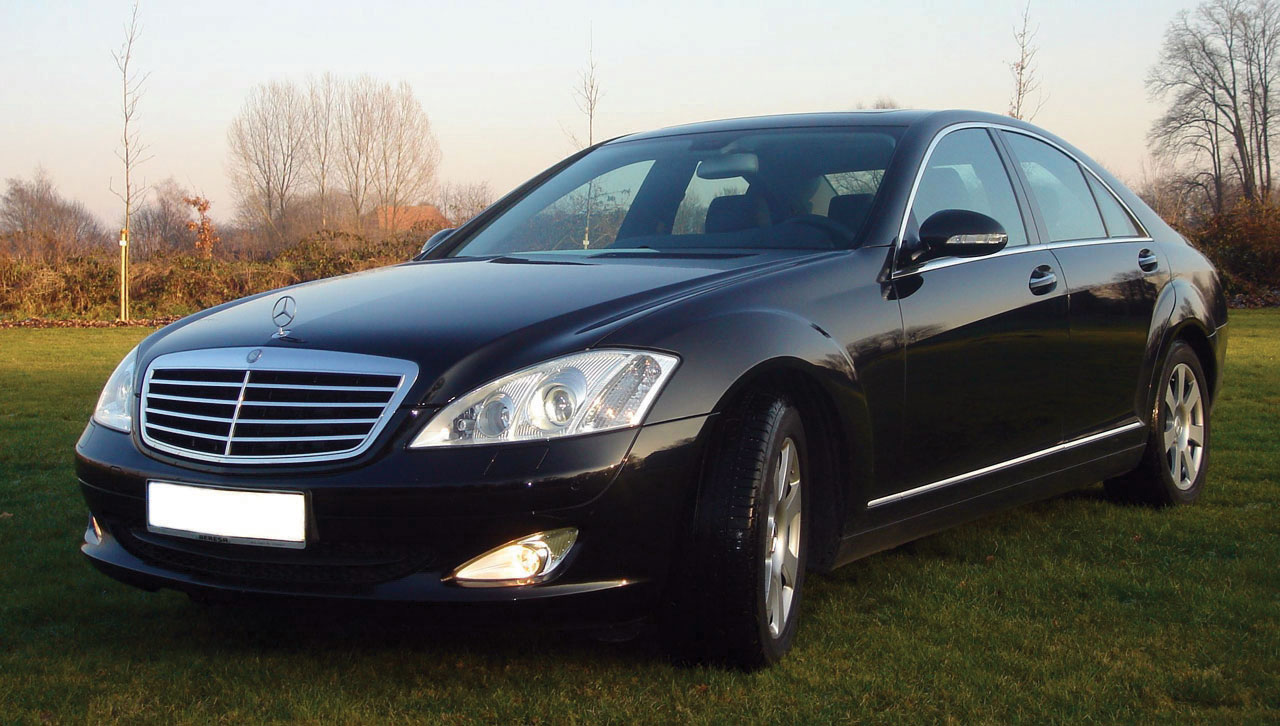
Developing a Focused Differentiation Strategy at Augustino LoPrinzi Guitars and Ukuleles
Augustino LoPrinzi Guitars and Ukuleles in Clearwater, Florida, builds high-end custom instruments. The founder of the company, Augustino LoPrinzi, has been a builder of custom guitars for five decades. While a reasonably good mass-produced guitar can be purchased elsewhere for a few hundred dollars, LoPrinzi’s handmade models start at $1,100, and some sell for more than $10,000. The firm’s customers have included professional musicians such as Dan Fogelberg, Leo Kottke, Herb Ohta (Ohta-San), Lyle Ritz, Andrés Segovia, and B. J. Thomas. Their instruments can be found at http://www.augustinoloprinzi.com. We asked Augustino about his firm (Short, 2007).
| Question: | Were there other entrepreneurial opportunities you considered before you began making guitars? |
| Augustino Loprinzi: | I originally thought of pursuing a career in commercial art, but I found my true love was in classical guitar building. I was trained by my father to be a barber from a very young age, and after my term in the service, I opened a barbershop. |
| Question: | What is the most expensive guitar you’ve ever sold? |
| Loprinzi: | $17,500. |
| Question: | How old were you when you started your first business in the guitar industry? |
| Loprinzi: | I was in my early twenties. |
| Question: | How did you get your break with more famous customers? |
| Loprinzi: | I think word of mouth had a lot do with it. |
| Question: | You have been active in Japan. Do the preferences of Japanese customers differ from those of Americans? |
| Loprinzi: | Yes. The Japanese want only high-end instruments. Aesthetics are very important to the Japanese along with high-quality materials and workmanship. The U.S. market seems to care in general less about ornamentation and more about quality workmanship, tone, and playability. |
| Question: | How do you stay ahead in your industry? |
| Loprinzi: | Always try to stay abreast on what the music industry is doing. We do this by reading several music industry publications, talking with suppliers, and keeping an eye on the trends going on in other countries because usually they come full circle. Also, for the past several years by following the Internet forums and such has been extremely beneficial. |
Advantages and Disadvantages of the Focused Strategies
Each generic strategy offers advantages that firms can potentially leverage to enhance their success as well as disadvantages that may undermine their success. In the case of focus differentiation, one advantage is that very high prices can be charged. Indeed, these firms often price their wares far above what is charged by firms following a differentiation strategy (Figure 5.16 “Executing a Focus Strategy”). REI (Recreational Equipment Inc.), for example, commands a hefty premium for its outdoor sporting goods and clothes that feature name brands, such as The North Face and Marmot. Nat Nast’s focus differentiation strategy centers on selling men’s silk camp shirts with a 1950s retro flair. These shirts retail for more than $100. Focused cost leaders such as Checkers Drive In do not charge high prices like REI and Nat Nast do, but their low-cost structures enable them to enjoy healthy profit margins. A second advantage of using a focus strategy is that firms often develop tremendous expertise about the goods and services that they offer. Consumers seek out not only the product itself, but are willing to pay a price premium for very knowledgeable sales staff to advise on which specialized product best suits their needs, such as higher-end cameras. In markets such as camping equipment where product comparison knowledge is important, rivals and new entrants may find it difficult to compete with firms following a focus strategy.
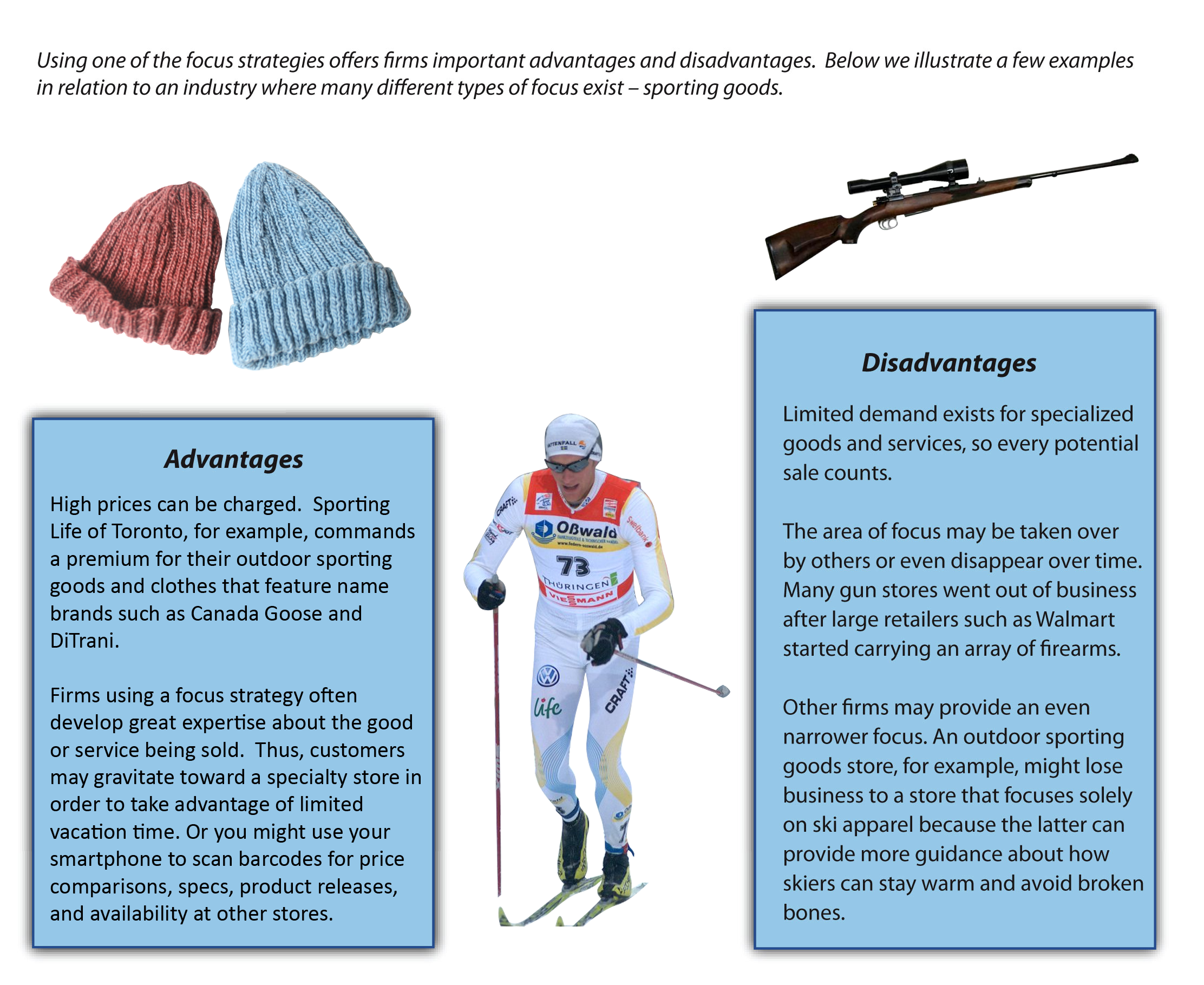
In terms of disadvantages, the limited demand available within a niche can cause problems. First, a firm could find its growth ambitions stymied. Once its target market is being well served, expansion to other markets might be the only way to expand, and this often requires developing a new set of skills. Also, the niche could disappear or be taken over by larger competitors. Many gun stores have struggled and even gone out of business since the U.S. Walmart and sporting goods stores such as Wholesale Sports and Canadian Tire have started carrying an impressive array of firearms.

Finally, damaging attacks may come not only from larger firms but also from smaller ones that adopt an even narrower focus. A sporting goods store that sells camping, hiking, kayaking, and skiing goods, for example, might lose business to a store that focuses solely on ski apparel because the latter can provide more guidance about how skiers can stay warm and avoid broken bones.
Strategy at the Movies
Zoolander
One man’s trash is another man’s fashion? That’s what fashion mogul Jacobim Mugatu was counting on in the 2001 comedy Zoolander. In his continued effort to be the most cutting-edge designer in the fashion industry, Mugatu developed a new line of clothing inspired “by the streetwalkers and hobos that surround us.” His new product line, Derelicte, characterized by dresses made of burlap and parking cones and pants made of garbage bags and tin cans, was developed for customers who valued the uniqueness of his…eclectic design. Emphasizing unique products is typical of a company following a differentiation strategy; however, Mugatu targeted a very specific set of customers. Few people would probably be enticed to wear garbage for the sake of fashion. By catering to a niche target market, Mugatu went from a simple differentiation strategy to a focused differentiation. Mugatu’s Derelicte campaign in Zoolander is one illustration of how a particular firm might develop a focused differentiation strategy.

Key Takeaways
- Focus strategies can be effective business-level strategies to the extent that a firm can match their goods and services to specific niche markets.
Exercises
- What are three different demographics that firms might target to establish a focus strategy?
- What is an example of a business that you think is focused in too narrow a fashion to be successful? How might it change to be more successful?
References
Cat’s Ass Coffee. (2010). Retrieved from http://www.catsasscoffee.com/order3.html
Onishi, N. (2010, April 17). From dung to coffee brew with no aftertaste. New York Times. Retrieved from http://www.nytimes.com/2010/04/18/world/asia/18civetcoffee.html?pagewanted=all
Porter, M. E. (1980). Competitive strategy: Techniques for analyzing industries and competitors. New York, NY: Free Press.
Short, J. C. (2007). A touch of the masters’ hands: An interview with Augustino and Donna Loprinzi. Journal of Applied Management and Entrepreneurship, 12, 103–109.
Image descriptions
Figure 5.12 image description: Focused Cost Leadership
Firms that compete based on price and target a narrow market are following a focused cost leadership strategy. Several examples of firms pursuing a focused cost leadership strategy are illustrated below.
- Redbox rents DVDs and video games through vending machines for only $1. Redbox machines are available at several locations in southern Ontario.
- Papa Murphy’s sells pizzas that customers cook at home. Because these inexpensive pizzas are baked at home rather than in the store, Papa Murphy’s may attract customers that might not otherwise be able to afford a prepared pizza. Papa Murphy’s has several outlets in western Canada.
- Claire’s three thousand+ locations target young women with inexpensive jewelry, accessories, and ear piercings. The strategy has worked: Claire’s has over three thousand locations and has stores in 95 percent of U.S. shopping malls.
- Providing indoor seating creates expenses for fast-food restaurants. Checkers Drive In keeps its costs low by not offering indoor seating. Checkers targets drive-thru customers and offers them big burgers at rock-bottom prices.
Figure 5.14 image description: Focused Differentiation
Firms that compete based on uniqueness and target a narrow market are following a focused differentiation strategy. Several examples of firms pursuing a focused differentiation strategy are illustrated below.
- Whole Foods Market focuses on selling natural and organic products. The supermarket’s reputation for high prices has led to a wry nickname – “Whole Paycheck” — but a sizable number of consumers are willing to pay a premium in order to feel better about the food they are buying. After all, you are what you eat!
- At Build-A-Bear Workshop, customers enjoy an interactive process of designing and assembling teddy bears. Build-A-Bear customers are willing to pay a premium price because they receive a unique, hands-on experience rather than simply buying a stuffed toy.
- You can buy a cinnamon roll cheaper elsewhere, but Cinnabon’s pricey pastries are so delicious that sugar-obsessed snackers line up to buy them. Perhaps in a nod to Cinnabon’s strategy, the brand is owned by a parent company named Focus Brands.
- The dedication of Mercedes-Benz to cutting-edge technology, styling, and safety innovations has made the firm’s vehicles prized by those who are rich enough to afford them.
Figure 5.16 image description: Executing a Focus Strategy
Using one of the focus strategies offers firms important advantages and disadvantages. Below we illustrated a few examples in relation to an industry where many different types of focus exist – sporting goods.
- Advantages
- High prices can be charged. Sporting Life of Toronto, for example, commands a premium for their outdoor sporting goods and clothes that feature name brands such as Canada Goose and DiTrani.
- Firms using a focus strategy often develop great expertise about the good or service being sold. Thus, customers may gravitate toward a specialty store in order to take advantage of limited vacation time. Or you might use your smartphone to scan barcodes for price comparisons, specs, product releases, and availability at other stores.
- Disadvantages
- Limited demand exists for specialized goods and services, so every potential sale counts.
- The area of focus may be taken over by others or even disappear over time. Many gun stores went out of business after large retailers such as Walmart started carrying an array of firearms.
- Other firms may provide an even narrower focus. An outdoor sporting goods store, for example, might lose business to a store that focuses solely on ski apparel because the latter can provide more guidance about how skiers can stay warm and avoid broken bones.
Generic business approaches that involve targeting a relatively narrow niche of potential customers.
A generic business strategy that requires competing based on price to target a narrow market.
A generic business strategy that requires offering unique features that fulfill the demands of a narrow market.

